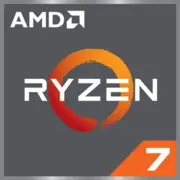AMD Ryzen 7 3800XT

AMD Ryzen 7 3800XT: Comprehensive Review of the 2025 Processor
Relevance, performance, and assembly recommendations
Key Characteristics: Architecture and Key Features
The AMD Ryzen 7 3800XT processor, released in 2020, retains its status as a reliable solution for budget high-performance builds by 2025. Its Matisse architecture based on TSMC 7nm FinFET offers a balance between energy efficiency and power.
- Cores and Threads: 8 cores/16 threads — perfect for multitasking.
- Cache: 32 MB L3 cache accelerates data processing in games and work applications.
- TDP: 105 watts — moderate power consumption for its class.
- Performance: In Geekbench 6 (2025) — 1758 (single-core) / 8492 (multi-core). This level is sufficient for modern gaming and rendering.
Key Features:
- Support for PCIe 4.0 for fast NVMe drives and GPUs.
- Precision Boost 2 technology for automatic overclocking up to 4.7 GHz.
- No integrated GPU — a focus on discrete solutions.
Compatible Motherboards: Sockets and Chipsets
The Ryzen 7 3800XT uses the AM4 socket, which remains popular by 2025 due to backward compatibility.
Recommended Chipsets:
- X570: Best choice for overclocking (e.g., ASUS ROG Crosshair VIII Hero, $250–300). Supports PCIe 4.0 on all slots.
- B550: Budget option with PCIe 4.0 for GPU and NVMe (MSI B550 Tomahawk, $150–180).
- Older Boards: A520/X470 require a BIOS update but work with PCIe 3.0 limitations.
Selection Tips:
- Check for heatsink on VRM — critical for stability under load.
- For overclocking, a board with 10+ power phases is needed.
Supported Memory: DDR4 vs DDR5
The processor does not support DDR5 — this is its main drawback in 2025. However, DDR4 memory remains relevant for budget builds.
Recommendations:
- Frequencies: Optimal 3200–3600 MHz (e.g., Corsair Vengeance LPX 32 GB, $90–120).
- Mode: Always use a dual-channel configuration.
- Timings: CL16 or lower to minimize latencies.
Power Supplies: Power Calculation and Selection
With a TDP of 105 watts and no iGPU, the main load falls on the graphics card.
Recommendations:
- Minimum PSU wattage: 650 watts (for RTX 4070 or RX 7700 XT).
- For top-tier GPUs (RTX 4090): 750–850 watts.
- Quality: Opt for models with an 80 Plus Gold certification (Corsair RM750x, $120–140).
Important: Cheap PSUs may operate unsafely under peak loads, especially during overclocking.
Pros and Cons of Ryzen 7 3800XT in 2025
Pros:
- Affordable price: $200–250 compared to $400 for Ryzen 7 7800X.
- Excellent multi-threaded performance for editing and rendering.
- PCIe 4.0 support — relevant for SSDs and new GPUs.
Cons:
- No DDR5 — a disadvantage in memory-speed-sensitive tasks.
- High thermal output when overclocked — requires a powerful cooler.
- Lack of iGPU — not suitable for office PCs without a graphics card.
Use Scenarios: Gaming, Work, Multimedia
- Gaming: On Ultra settings at Full HD/1440p (Cyberpunk 2077 — 75–90 FPS). For 4K, GPU matters more than CPU.
- Work Tasks: Video editing in Premiere Pro, 3D rendering in Blender. 16 threads speed up rendering by 20% compared to 6-core CPUs.
- Streaming: NVENC from the GPU reduces load on the CPU — 3800XT can handle encoding in OBS without lag.
Practical Example: A build with 3800XT + RTX 4060 Ti ($1200–1400) is optimal for streamers and gamers.
Comparison with Competitors
- Intel Core i7-12700KF ($280): Higher IPC and DDR5 support but more expensive. Better for gaming, parity in multi-threaded tasks.
- Ryzen 7 5700X ($220): A lower model with similar architecture. 3800XT outperforms in overclocking.
- Ryzen 5 7600 ($230): Newer but with 6 cores — a disadvantage in rendering.
Practical Assembly Tips
1. Cooling: A cooler like Noctua NH-D15 ($110) or a 240mm AIO (NZXT Kraken X53, $130).
2. Case: At least 2 intake fans. Example — Lian Li Lancool II Mesh ($90).
3. BIOS: Update motherboard firmware before installing the CPU.
4. Overclocking: Voltage no higher than 1.35V — risk of overheating!
Final Conclusion: Who Should Consider the Ryzen 7 3800XT?
This processor is the choice for:
- Building an entry-level PC for gaming and work on a limited budget ($800–1200).
- Not willing to pay extra for DDR5 and new platforms.
- Valuing upgrade potential on AM4 (e.g., to Ryzen 9 5900X).
Alternative for 2025: If the budget allows, it’s better to opt for Ryzen 5 7600 or Intel i5-13600KF with DDR5 support. But for those searching for "budget power," the 3800XT remains a viable option.
This article is relevant as of April 2025. Prices listed are for new devices in the USA.
Basic
CPU Specifications
Memory Specifications
GPU Specifications
Miscellaneous
Benchmarks
Compared to Other CPU
Share in social media
Or Link To Us
<a href="https://cputronic.com/cpu/amd-ryzen-7-3800xt" target="_blank">AMD Ryzen 7 3800XT</a>